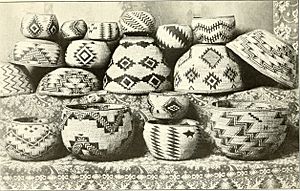Atsugewi facts for kids
| Total population | |
|---|---|
| 200 (1977), 1,350 combined with Achomawi (2000) |
|
| Regions with significant populations | |
| Languages | |
| English, formerly Atsugewi | |
| Religion | |
| traditional tribal religion | |
| Related ethnic groups | |
| other members of the Pit River Tribe, including Achomawi |
The Atsugewi are a group of Native American people who live in northeastern California, United States. Their traditional lands are near Mount Shasta, around the Pit River and areas like Hat Creek and Dixie Valley. They are closely related to the Achomawi people.
The Atsugewi were made up of two main groups: the Atsugé and the Apwaruge. The Atsugé, also known as the "pine-tree people," lived near Hat Creek. The Apwaruge, or "juniper-tree people," lived in Dixie Valley. They lived south of the Achomawi.
Contents
Atsugewi History
For a long time, the Atsugewi people lived by hunting animals and gathering plants. They lived in small groups and did not have one central leader. Their culture was divided into two main groups based on where they lived.
People from Hat Creek were called the "pine tree people" or Atsuge. People from Apwariwa or Dixie Valley were known as the "juniper tree people" or Apwaruge. These two groups often traded gifts and goods with each other.
Neighbors and Trade
The Atsugewi had different relationships with their neighbors, the Achomawi people. Sometimes, there were disagreements, especially when Atsugewi people traveled through Achomawi land to collect obsidian, a type of volcanic glass. However, the Achomawi were usually the main people the Atsugewi traded with for handmade goods and food.
The Atsugewi also had some contact with the Klamath and Modoc tribes to the north. It is thought that they traded a lot before the Klamath and Modoc started using horses around the 1820s. Sometimes, Modoc groups would attack Atsugewi settlements. People who were captured might be traded to other tribes.
Atsugewi-made bows were very popular with neighboring tribes like the Klamath, Paiute, Modoc, and Achomawi. These bows, called dumidiyi, were similar to those made by the Yurok. The best bows were made from yew wood by the Atsuge group.
By 1870, the Atsugewi had peaceful relationships with Paiute groups. Yew bows became a common item for trade. Paiute visitors would bring animal skins (buckskins), red ochre (a type of pigment), glass beads, guns, and shell currency. In return, the Atsugewi traded their baskets and bows.
Some tribes, including the Atsugewi, started wearing buckskin clothing, similar to the Plains Indians. This new clothing was called dwákawi by the Atsugewi. They usually only smoked (treated with smoke) buckskins for special occasions. Daily clothes were not smoked, which meant they could get damaged by water.
Atsugewi Culture
Language
The Atsugewi language is part of the Palaihnihan language family. By 1994, only about three people still spoke Atsugewi. Most members of the tribe now speak English.
Atsugewi Today
Today, many Atsugewi people are part of the Pit River Tribe. Some Atsugewi are also members of the Susanville Indian Rancheria.
Population Changes
It is hard to know exactly how many Atsugewi people lived in California before Europeans arrived. One estimate suggested that the combined population of the Achomawi and Atsugewi in 1770 was about 3,000 people. Another estimate for just the Atsugewi people was around 850.
By 1910, the combined population of the Achomawi and Atsugewi was estimated to be 1,100. In 1936, the Atsugewi population was about 500.
See also
 In Spanish: Atsugewi para niños
In Spanish: Atsugewi para niños
- Atsugewi language
- Atsugewi traditional narratives
- Achomawi


